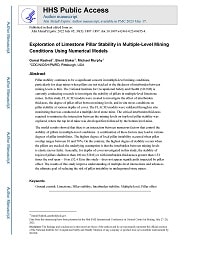Mining Publication: Exploration of Limestone Pillar Stability in Multiple-level Mining Conditions Using Numerical Models
Original creation date: May 2023
Authors: G Rashed, B Slaker, M Murphy
Pillar stability continues to be a significant concern in multiple-level mining conditions, particularly for deep mines when pillars are not stacked or the thickness of interburden between mining levels is thin. The National Institute for Occupational Safety and Health (NIOSH) is currently conducting research to investigate the stability of pillars in multiple-level limestone mines. In this study, FLAC3D models were created to investigate the effect of interburden thickness, the degree of pillar offset between mining levels, and in situ stress conditions on pillar stability at various depths of cover. The FLAC3D models were validated through in situ monitoring that was conducted at a multiple-level stone mine. The critical interburden thickness required to minimize the interaction between the mining levels on top-level pillar stability was explored, where the top level mine was developed first followed by the bottom level mine.
The model results showed that there is an interaction between numerous factors that control the stability of pillars in multiple-level conditions. A combination of these factors may lead to various degrees of pillar instabilities. The highest degree of local pillar instability occurred when pillar overlap ranges between 10 and 70%. On the contrary, the highest degree of stability occurs when the pillars are stacked, the underlying assumption is that the interburden between mining levels is elastic (never fails). Generally, for depths of cover investigated in this study, the stability of top-level pillars shallower than 100 m (328 ft) or with interburden thicknesses greater than 1.33 times the roof span—16 m (52.4 ft) in this study—does not appear significantly impacted by pillar offset. The results of this study improve understanding of multiple-level interactions and advances the ultimate goal of reducing the risk of pillar instability in underground stone mines.

- Analysis of Multiple Seam Stability
- A Case Study of Multi-Seam Coal Mine Entry Stability Analysis with Strength Reduction Method
- Deep Cover Pillar Recovery in the US
- Multiple-Seam Mining in the United States: Background
- Pillar Strength and Design Methodology for Stone Mines
- Proceedings: New Technology for Ground Control in Multiple-seam Mining
- Simplified Pre- and Post-Processing Technique for Performing Finite-Element Analyses of Deep Underground Mines
- The State-of-the-Art in Coal Pillar Design
- Using Site Case Histories of Multiple Seam Coal Mining to Advance Mine Design
- Using the Coal Mine Roof Rating (CMRR) to Assess Roof Stability in U.S. Coal Mines